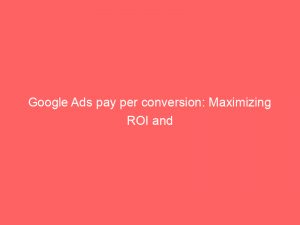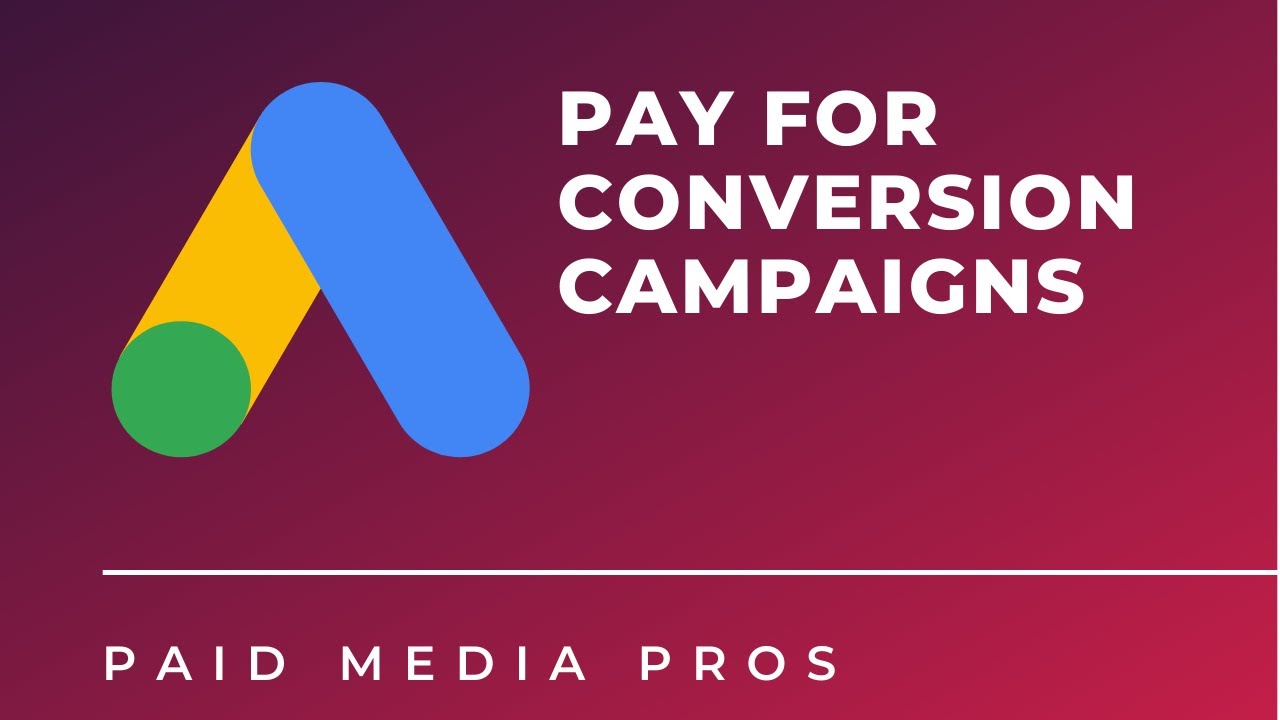In the world of online advertising, staying ahead of the game is crucial. And now, Google Ads has once again revolutionized the way advertiserspay for conversions.
Say goodbye to the traditional pay-per-click model and welcome the era of pay-per-conversion. Imagine only paying when a user completes a desired action, without ever exceeding your set cost-per-acquisition (CPA) target.
This game-changing feature, known as Target CPA with Display campaigns, comes with its own set of requirements and guidelines. So, if you’re ready to unlock the potential of Google Ads and take your campaigns to new heights, keep reading to discover the power of pay-per-conversion advertising.
Table of Contents
- google ads pay per conversion
- Introduction To Pay Per Conversion In Google Ads
- Benefits Of Paying For Conversions Instead Of Clicks
- How To Get Started With Pay-Per-Conversion Campaigns
- Account Requirements For Using Pay Per Conversion
- Timeframe For Conversions To Be Eligible For Pay-Per-Conversion
- Setting Target CPA For Pay-Per-Conversion Campaigns
- Flexible Budgeting Rules With Pay Per Conversion
- Adjusting Monthly Budgets And Pacing For Pay-Per-Conversion Campaigns
google ads pay per conversion
Google Ads offers the option for advertisers to pay per conversion instead of paying for clicks on Display campaigns. This means that advertisers will be charged only when a user converts on their website or app, and they will never pay more than their target cost per acquisition (CPA).
This feature is available for Display campaigns that are using Target CPA bidding. To get started with pay-per-conversion, advertisers can visit the Help Center or use the Google Ads user interface.
However, certain requirements must be met, such as having an account with more than 100 conversions in the last 30 days and ensuring that 90% of the conversions occur within 7 days after someone clicks on an ad. The Target CPA for campaigns and ad groups using pay per conversion should be set below $200 USD.
Pay per conversion allows for more flexible budgeting rules, and daily spend may exceed the average daily budget by more than 2 times. The initial monthly budget for a campaign using pay per conversion can be adjusted, and monthly budgets for conversions are calculated based on the average daily budget multiplied by 30.4.
It is important to note that pacing may not be even for pay-per-conversion campaigns, and the monthly budget may be exhausted before the end of the month. Detailed instructions are provided on how to set up Google Ads campaigns with a focus on conversions and pay-per-conversion bidding.
Key Points:
- Google Ads allows advertisers to pay per conversion instead of paying for clicks on Display campaigns.
- Advertisers are charged only when a user converts on their website or app, and will not pay more than their target cost per acquisition (CPA).
- Pay-per-conversion is available for Display campaigns using Target CPA bidding.
- Requirements for pay-per-conversion include having an account with more than 100 conversions in the last 30 days and ensuring that 90% of conversions occur within 7 days of an ad click.
- Pay per conversion allows for flexible budgeting rules, with daily spend able to exceed the average daily budget by over 2 times.
- Monthly budgets for pay-per-conversion campaigns are calculated based on the average daily budget multiplied by 30.4, but pacing may not be even and the budget may be exhausted before the end of the month.
Sources
https://support.google.com/google-ads/answer/7528254?hl=en
https://support.google.com/google-ads/answer/9208548?hl=en
https://support.google.com/google-ads/answer/7528254?hl=en-GB
https://www.impactplus.com/blog/google-ads-adds-pay-per-conversions
Check this out:
💡 Pro Tips:
1. When setting up a Google Ads campaign with pay-per-conversion bidding, make sure your account has at least 100 conversions in the last 30 days to be eligible.
2. For pay-per-conversion to work effectively, the majority of your conversions should occur within 7 days after someone clicks on your ad.
3. Set your Target CPA below $200 USD for campaigns and ad groups using pay per conversion to optimize your budget and maximize conversions.
4. With pay per conversion, you have more flexibility in budgeting. Your daily spend may exceed the average daily budget by more than 2 times.
5. Keep in mind that pacing may not be even for pay-per-conversion campaigns. Your monthly budget may be exhausted before the end of the month, so make adjustments accordingly.
Introduction To Pay Per Conversion In Google Ads
Google Ads, the popular online advertising platform, introduced a groundbreaking feature on December 13, 2018, which allows advertisers to pay for conversions instead of clicks on Display campaigns. This new capability provides advertisers with a greater level of control and accountability over their advertising spend.
With pay per conversion, advertisers are only charged when a user takes a desired action, such as making a purchase or filling out a form on their website or app. Furthermore, advertisers will never pay more than their target cost per acquisition (CPA), ensuring that their advertising costs remain within their set budget.
Benefits Of Paying For Conversions Instead Of Clicks
The shift towards paying for conversions rather than clicks offers several key benefits for advertisers. Firstly, it aligns advertising costs directly with actual business results.
By only paying when a user converts, advertisers can be confident that their investment is driving tangible outcomes and value for their business. Secondly, this payment model provides a more accurate measure of return on investment (ROI).
Rather than fixating on clicks, advertisers can focus on the actions that truly matter to their business and evaluate the success of their campaigns based on conversions. Furthermore, paying for conversions incentivizes advertisers to optimize their campaigns for greater effectiveness and efficiency, as every click must now be more likely to result in a conversion.
How To Get Started With Pay-Per-Conversion Campaigns
Getting started with pay-per-conversion campaigns in Google Ads is a straightforward process. Advertisers can begin by visiting the Help Center or using the user-friendly Google Ads interface.
By following the provided instructions, advertisers can create campaigns with a specific focus on conversions and utilize the pay-per-conversion bidding strategy. This strategy is available exclusively for campaigns using Target CPA in conjunction with Display campaigns.
Account Requirements For Using Pay Per Conversion
In order to utilize the pay-per-conversion feature, advertisers must ensure that their Google Ads account meets specific requirements. Firstly, the account must have generated at least 100 conversions within the last 30 days.
This threshold is in place to ensure that advertisers have sufficient conversion data to make informed decisions and optimize their campaigns effectively. Meeting this requirement demonstrates that the account has reached a certain level of maturity and has acquired enough data to accurately target and optimize conversions.
Timeframe For Conversions To Be Eligible For Pay-Per-Conversion
For conversions to be eligible for pay-per-conversion, they must occur within a specific timeframe. Google Ads stipulates that 90% of conversions should take place within 7 days after a user clicks on an ad.
This timeframe ensures that advertisers are paying for the most relevant and timely conversions, minimizing the possibility of paying for conversions that occur long after the initial interaction. By focusing on recent conversions, advertisers can make more accurate assessments of their campaign’s performance and make real-time adjustments to maximize their return on investment.
Setting Target CPA For Pay-Per-Conversion Campaigns
To achieve optimal results with pay-per-conversion campaigns, advertisers must set their target CPA strategically. It is recommended to set a target CPA below $200 USD for campaigns and ad groups that are utilizing the pay-per-conversion feature.
This guideline helps ensure that advertising costs remain within reasonable parameters and align with the advertiser’s desired cost per acquisition. By setting an appropriate target CPA, advertisers can strike a balance between acquiring high-quality conversions and managing their advertising budget effectively.
Flexible Budgeting Rules With Pay Per Conversion
One of the advantages of pay-per-conversion campaigns is the flexibility it allows in budgeting rules. Advertisers can now surpass their average daily budget by more than twice its value on a daily basis.
This flexibility enables advertisers to seize opportunities when the demand for their products or services is high, maximizing their reach and potential conversions. However, it is important to note that the monthly budget for a pay-per-conversion campaign can be adjusted, ensuring that advertisers maintain control over their overall advertising spend.
Adjusting Monthly Budgets And Pacing For Pay-Per-Conversion Campaigns
When utilizing pay-per-conversion campaigns, it is essential to understand that pacing may not be evenly distributed throughout the month. Due to the nature of conversions occurring sporadically, it is possible for the monthly budget to be exhausted before the end of the month.
Advertisers should remain vigilant and monitor their campaign’s performance regularly to avoid any potential budget shortfalls. To adjust monthly budgets effectively, advertisers can calculate it based on the average daily budget multiplied by 30.4, providing a more accurate estimate of monthly advertising costs.
In conclusion, the introduction of pay-per-conversion in Google Ads offers advertisers a powerful tool to maximize their ROI and profitability. By aligning advertising costs with actual conversions, advertisers can better evaluate the success of their campaigns and optimize their strategies accordingly.
With flexible budgeting rules and the ability to adjust monthly budgets, pay-per-conversion campaigns provide advertisers with greater control and flexibility in managing their advertising spend. Advertisers looking to take their campaigns to the next level should explore the possibilities offered by pay-per-conversion in Google Ads.












